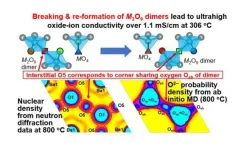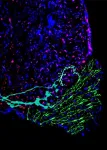(Press-News.org) The vision system, evolved over millions of years, is highly complex. To make vision sensitive throughout the whole range of visible wavelengths, Nature employs a supramolecular chemistry approach. The visual pigment, cis-retinal, changes its shape upon capturing a photon. This shape transformation is accompanied by changes in the supramolecular organization of the surrounding proteins, subsequently triggering a cascade of chemical signaling events that get amplified and eventually lead to visual perception in the brain.
“Some deep-sea fish have evolved antenna-like molecules capable of absorbing photons in the red wavelength range, whose abundance at great depths is close to zero. After absorbing a photon, this antenna molecule transfers its energy to the nearby retinal molecule, thus inducing its conformational change from the cis to trans-retinal. In synthetic systems, such process would enable using low-energy light for applications in for instance energy storage or controlled drug release”, explains the lead author of the work Prof. Rafal Klajn from the Weizmann Institute of Science.
Inspired by this phenomenon, the researchers developed a superior supramolecular machine capable to efficiently convert widely used synthetic photoswitchable molecules – azobenzenes – from the stable to the metastable conformation with almost any wavelength of visible light. The approach includes a metal–organic cage filled with one azobenzene molecule and one light-absorbing antenna molecule, the sensitizer. In close confinement inside the supramolecular cage, chemical processes that would not take place in normal conditions, become possible.
“A common problem of azobenzenes is that they cannot efficiently undergo photoswitching from the stable trans form to the metastable cis form upon low-energy red and near-infrared light, but the process has to be driven by UV light. This substantially limits their applications in fields such as photocatalysis or photopharmacology. Now, using the supramolecular caging approach we can reach almost quantitative trans-to-cis isomerization with any color of visible range,” says Dr. Nikita Durandin, Academy of Finland Research Fellow in Supramolecular Chemistry of Bio- and Nanomaterials group, who has been working with sensitization approaches in Tampere University for the last 7 years.
“Time-resolved spectroscopic studies done at Tampere University revealed that the photochemical processes triggering the isomerization happen superfast, in the nanosecond range. In other words, almost 1 billion times faster than the blink of your eyes,” continues Dr. Tero-Petri Ruoko, Marie Sklodowska-Curie Fellow in Smart Photonics Materials group, and expert in ultrafast spectroscopy.
“Once you shine light on this supramolecular cage, it quickly converts almost all of the trans isomers into cis isomers. Simple mixing of components and light that matches the absorption profile of the sensitizer is enough to make this machinery work,” he adds.
According to Prof. Arri Priimägi, the leader of Smart Photonics Materials group specializing in light-active materials, the study presents a new approach for activating photoresponsive molecules with low-energy light, pushing them out from their thermodynamic equilibrium utilizing chemistry that only takes place under confinement.
It took millions of years of evolution for the eye of deep-sea fish to emerge. Learning from that, the research led by Rafal Klajn’s group extended these concepts to synthetic materials in less than 5 years.
“We are already working on the next generation of the light-driven supramolecular machines, aiming at applying the developed methodologies in soft robotics and light-activated drug delivery systems,” concludes Priimägi.
The scientific article on the research “Disequilibrating azobenzenes by visible-light sensitization under confinement” has been published in the journal Science.
END
A deep-sea fish inspired researchers to develop supramolecular light-driven machinery
2023-11-17
ELSE PRESS RELEASES FROM THIS DATE:
Shedding light on unique conduction mechanisms in a new type of perovskite oxide
2023-11-17
The remarkable proton and oxide-ion (dual-ion) conductivities of hexagonal perovskite-related oxide Ba7Nb3.8Mo1.2O20.1 are promising for next-generation electrochemical devices, as reported by scientists at Tokyo Tech. The unique ion-transport mechanisms they unveiled will hopefully pave the way for better dual-ion conductors, which could play an essential role in tomorrow’s clean energy technologies.
Clean energy technologies are the cornerstone of sustainable societies, and solid-oxide fuel cells (SOFCs) and proton ceramic fuel cells (PCFCs) are among the most promising types of electrochemical devices for green power generation. These devices, however, still ...
UK’s Rural Physician Leadership Program, Anthem Medicaid announce new rural medicine scholarships
2023-11-17
MOREHEAD, Ky. (Nov. 17, 2023) — In celebration of National Rural Health Day, yesterday the University of Kentucky College of Medicine and Anthem Blue Cross and Blue Shield Medicaid in Kentucky announced new scholarship opportunities for UK’s Rural Physician Leadership Program (RPLP). The Anthem Rural Medicine Scholarships will provide $100,000 to offset the cost of medical school for students in the RPLP.
In a state that suffers from high rates for many chronic, ...
Heart repair via neuroimmune crosstalk
2023-11-17
Unlike humans, zebrafish can completely regenerate their hearts after injury. They owe this ability to the interaction between their nervous and immune systems, as researchers led by Suphansa Sawamiphak from the Max Delbrück Center now report in the journal Developmental Cell.
Each year, more than 300,000 people in Germany have a myocardial infarction – the technical term for heart attack. The number of people surviving a heart attack has increased significantly, but this severe cardiac event causes irreparable damage to their hearts. A heart attack ...
BU researchers develop new method to help with analysis of single cell data
2023-11-17
(Boston)—CITE-seq (cellular indexing of transcriptomes and epitopes) is an RNA sequencing-based method that simultaneously quantifies cell surface protein and transcriptomic data within a single cell readout. The ability to study cells concurrently offers unprecedented insights into new cell types, disease states or other conditions.
While CITE-seq solves the problem of detecting a limited number of proteins while using single-cell sequencing in an unbiased way, one of its limitations is the high levels of background noise that can hinder analysis.
To rectify ...
Azerbaijan women behind global average for thalassemia screening and genetic counselling | BGI Insight
2023-11-17
5.2% of the global population carry hemoglobin abnormalities, resulting in 300,000 to 400,000 children born with severe hemoglobinopathies annually. Thalassemia, a hereditary hemoglobinopathy, occurs in 4.4 out of every 10,000 live births, and is prevalent in Mediterranean coastal areas, Africa, the Middle East, Southeast Asia, and southern China.
To facilitate greater understanding of thalassemia, a hereditary hemoglobinopathy, BGI Genomics today released its State of Thalassemia Awareness Report. This report assesses the level of knowledge and attitudes related to the associated health risks, thalassemia carrier ...
Alliance and WEF sign agreement for Food Action Alliance
2023-11-17
The Alliance Bioversity International and CIAT signed an agreement with the World Economic Forum that enables the Alliance to manage initiatives under the Food Action Alliance, a movement led by the World Economic Forum for transforming sustainable food systems.
The Alliance would establish and manage initiatives in Latin America, the Caribbean, and other regions under the Food Action Alliance to boost the transformation of food systems, facilitating and scaling up multi-stakeholder flagship initiatives in specific countries mostly with multi-national companies such as Bayer, Microsoft, PepsiCo, AB InBev; among others.
The Food Action Alliance will continue to grow initiatives ...
USDA introduces a multi-year plan to strengthen U.S. genebank management of plant germplasm
2023-11-17
WASHINGTON, November 17, 2023 – The U.S. Department of Agriculture (USDA) released today the National Strategic Germplasm and Cultivar Collection Assessment and Utilization Plan in support of the Agricultural Research Service (ARS) U.S. National Plant Germplasm System’s (NPGS) mission.
The USDA-ARS NPGS is confident that implementing this plan will address current operational and research challenges. The collection is vital for maintaining the nation’s food supply by providing breeders and researchers the germplasm they need to furnish U. S. consumers with abundant, ...
Unravelling the secrets of neurodegenerative diseases, one protein at a time
2023-11-17
Proteins misfolding and clumping together, a process known as aggregation, is a key feature seen in several neurological conditions, including Alzheimer's and Parkinson's diseases.
These disorders involve the formation of small, potentially harmful structures called oligomers, which could serve as valuable indicators for early diagnosis. They are incredibly small, however, and much rarer than the healthy non-aggregated proteins. This makes it hard to detect and measure them accurately.
In collaboration with UCB Biopharma, researchers from the University of Edinburgh’s ...
A world's first in validating a UNFCCC report by a cost-efficient and transparent method to measure CO2 emission estimates using GOSAT
2023-11-17
Researchers in Japan and Mongolia have carried out the world's first instance of incorporating satellite-based CO2 emission estimates into a GHG emission report as the verification on the Second Biennial Update Report (BUR2) of Mongolia submitted to the UNFCCC on 15 November 2023, resulting in high accuracy match with actual reported values, reports a new study published online in Scientific Reports in 2023.
Countries have reported their CO2 emissions to the UNFCCC, primarily from human activities and a significant contributor to climate change. ...
New cooling mechanism set to revolutionize conventional environmentally harmful refrigeration technologies
2023-11-17
Approximately one-fifth of the world's electric energy is dedicated to refrigeration, and the International Energy Agency anticipates a twofold increase in the number of air conditioning units by 2040. Despite a century of advancements, existing refrigeration systems, relying on vapour compression, have hit their thermodynamic threshold. These systems not only emit greenhouse gases, contributing to environmental issues, but also produce significant noise. Prioritizing the development of energy-efficient and eco-friendly systems is thus paramount to address global warming ...







